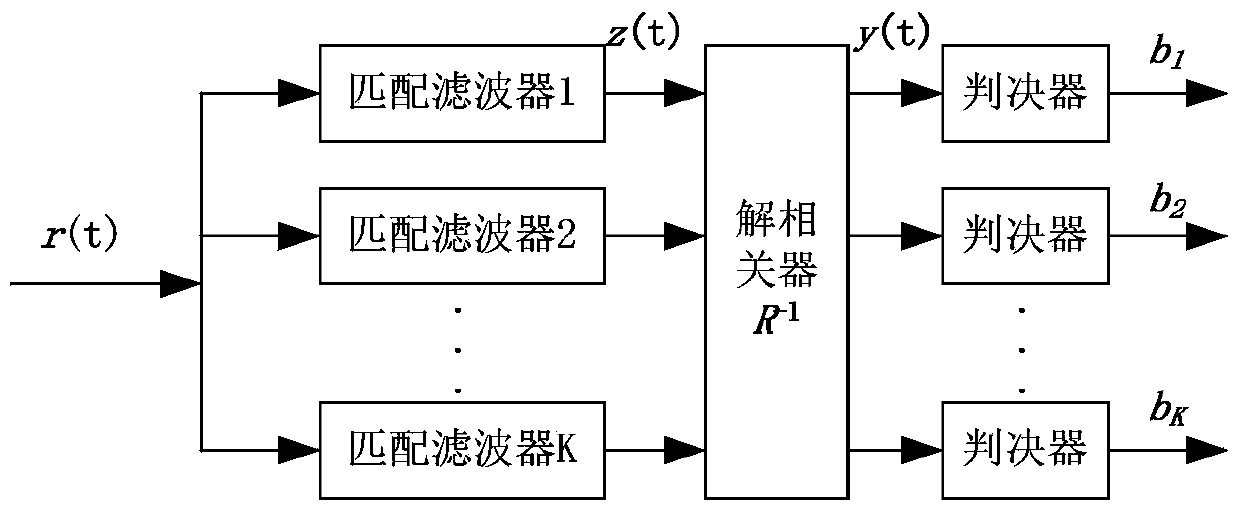Multiplexing orthogonal prolate spheroidal wave function pulse-modulated signal demodulation method
A technology of pulse modulation signal and demodulation method, applied in the direction of multi-frequency code system, etc., can solve the problems of instability, unusability, fluctuation of demodulation performance, etc.
- Summary
- Abstract
- Description
- Claims
- Application Information
AI Technical Summary
Problems solved by technology
Method used
Image
Examples
Embodiment 1
[0135] Using 2 or 4 orthogonal PSWF pulses as the modulation waveform, setting the pulse group to produce different delays after passing through the channel, resulting in the destruction of the orthogonality of the pulse group, and using decorrelation and matched filtering methods for demodulation, respectively, The BER performance of the system is as Figure 6 shown.
[0136] Figure 6 Among them, "MF" means matched filter demodulation, "Dec" means decorrelation demodulation, and "delay=x%" means that the second pulse is delayed by x% symbol periods relative to the first pulse. Figure 6 "delay=[x, y, z]" in (b) means that the 2nd, 3rd, and 4th pulses are respectively delayed by x%, y%, and z% symbol periods relative to the first pulse. The analysis shows that when the signal-to-noise ratio is low, the performance of the decorrelation detection method is similar to that of the matched filter. With the increase of the signal-to-noise ratio, the advantages of the decorrelatio...
Embodiment 2
[0138] Under different pulse delay conditions, four orthogonal PSWF modulation waveforms are demodulated by using matched filter method, decorrelation detection method and MMSE demodulation method respectively. It is set that the pulse group produces different delays after passing through the channel, which leads to the destruction of the orthogonality of the pulse group, and the result is as follows Figure 7 shown.
[0139] Figure 7 Among them, "MF" means matched filter demodulation, "Dec" means decorrelation demodulation, "MMSE" means MMSE demodulation, "delay=x%" means that the second pulse is delayed relative to the first pulse x% symbol periods. Figure 7 "delay=[x, y, z]" in (b) means that the 2nd, 3rd, and 4th pulses are respectively delayed by x%, y%, and z% symbol periods relative to the first pulse. At "delay=[0.4,1.6,1.6]", MMSE detection at BER=10 -4 Eb / N required for 0 About 4dB lower than traditional matched filter demodulation.
[0140] When there is no ...
Embodiment 3
[0142] Under different pulse delay conditions, assuming that each pulse is of equal amplitude, three methods of matched filtering, decorrelation and whitening transform decorrelation are used for demodulation. Figure 8 It is the demodulation bit error rate diagram in the case of 2 pulses. Figure 9 It is the demodulation bit error rate diagram in the case of 4 pulses.
[0143] Figure 8 In (a), the performance comparison of the three demodulation methods when the second pulse is delayed by 0%, 0.4%, and 0.8% relative to the first pulse. From Figure 8 It can be seen from (a) that for different pulse delays, the whitening transform decorrelation detection method is better than the matched filter detection method, and has advantages over the traditional decorrelation detection method in the case of small signal-to-noise ratio. Figure 8 (b) is a partial enlarged picture of the small SNR interval. It can be seen from the figure that in the case of small SNR, the performance o...
PUM
 Login to View More
Login to View More Abstract
Description
Claims
Application Information
 Login to View More
Login to View More - R&D
- Intellectual Property
- Life Sciences
- Materials
- Tech Scout
- Unparalleled Data Quality
- Higher Quality Content
- 60% Fewer Hallucinations
Browse by: Latest US Patents, China's latest patents, Technical Efficacy Thesaurus, Application Domain, Technology Topic, Popular Technical Reports.
© 2025 PatSnap. All rights reserved.Legal|Privacy policy|Modern Slavery Act Transparency Statement|Sitemap|About US| Contact US: help@patsnap.com



